Jess Valice was supposed to be a doctor. As the President of the Neuroscience Club and a Biopsychology major in college, she knew that within a year or two she would have transitioned into med school, been placed in her first residency, and followed the typical doctoral path. But there was always something gnawing at her on the inside. A feeling she couldn’t alleviate as she sat in front of two web browser windows — one showing her latest physics homework assignment and the other displaying Jerry Saltz’s latest article on Vulture. Valice knew that her idealized career path meant a life without painting.
The urge started out small — Valice contemplated taking a year off to pursue painting and see if she had what it took to formulate a practice. But at a certain point, the desire to shift her trajectory became overwhelming and to the surprise of her peers and herself, she decided to follow her gut and leave school to paint.
Valice now paints portraits and scenes from real life, but with a playful and modern-day take. Whether it’s an even-tempered woman in all-black behind the wheel of a car, or an equally composed woman sitting in a horse-shaped pool floaty wielding a Super Soaker, Valice’s subject matter bounces between reality and one she has perceived. Each of her characters is an amalgamation of people she’s encountered on social media, books, and real-life, along with the feelings, notions, and conversations she projects on them. The Los Angeles-based artist smuggles small clues in the form of recognizable contemporary objects — Modelos, goon masks, an Adidas logo — that suggest a deeper narrative about her subjects. Every detail becomes significant in dissecting the personal universes that Valice creates around each character. And although the scenery may change between paintings, the emotionless gaze that emanates from these characters’ faces depicts a narrative of being alone, of chosen loneliness.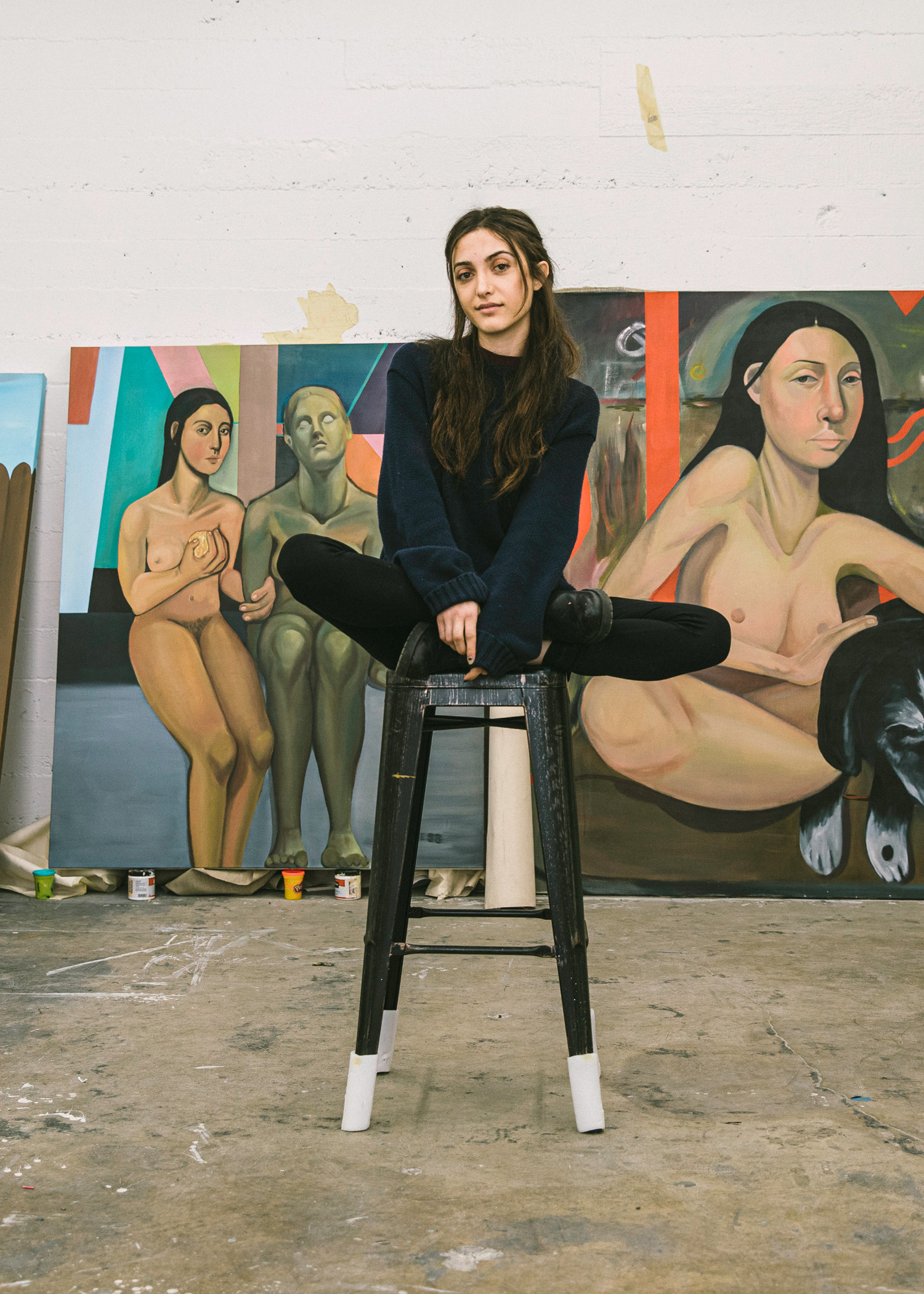
Tell me about your practice. When did it start and where do you feel like you are right now?
I’ve been drawing my entire life, I didn’t really start painting until about three years ago. So it’s really new. I was studying science, more specifically biology in college and I was loving it. It was awesome, but at a certain point, I realized I wasn’t going to have time to paint if I kept going down this path. I wanted to see what it would be like to take a year to pursue being an artist and put in absolutely everything. I wanted to see if I could really do it. It’s been the only thing that I feel like I can really do. I’ve been working so hard to find my style and get my message out and put all of my emotion and love into these narratives. So I kind of just started and then began working with Canyon Castator. He taught me a bunch and I’ve just been working at it ever since.
How did you decide to make that transition? Was there someone who encouraged you? Or were you wholeheartedly pushing yourself to explore this new path?
It was just myself. I always wanted to go to art school; it’s either like, “It’s too expensive and you’re not going to make a living,” or…no, it’s usually just that. I finished all the fun science classes for my major and I was in all of these crazy math classes. It was so overwhelming. At one point, I looked at my computer screen and I had one web browser of physics homework on one side and on the other side of the screen was Jerry Saltz’s latest article on Vulture, and I remember just going and back and forth, thinking to myself, “I bet I could do that. I bet if I worked really hard, I could have my name up there and I can be killing it.” So I think at some point, this feeling just became overwhelming and the idea kept growing.

Taking that leap and completely changing the trajectory of your planned path takes some guts.
Oh, it’s terrifying. I’m still scared. I see all my friends that were in my program and they’re either really stressing out or they’re killing it. I could’ve gone either way in the end.
Tell me a little bit about your practice now, how do you feel? Are you happy with the work that you’re creating right now?
I’m definitely happy with what’s going on. Some of these paintings in here are pretty old but I like to keep them around. I like to see that I’m evolving, turning into something and figuring out a character, a message, and a motif. It feels good to explain these ideas and it feels good for other people to create their own ideas about my work. I try to make enigmatic work so that other people can put their own narrative to it. It’s not so straightforward; it’s quite the opposite. It doesn’t make any sense. I kind of love how my subjects have no emotion. I want to keep that going and keep people going nuts.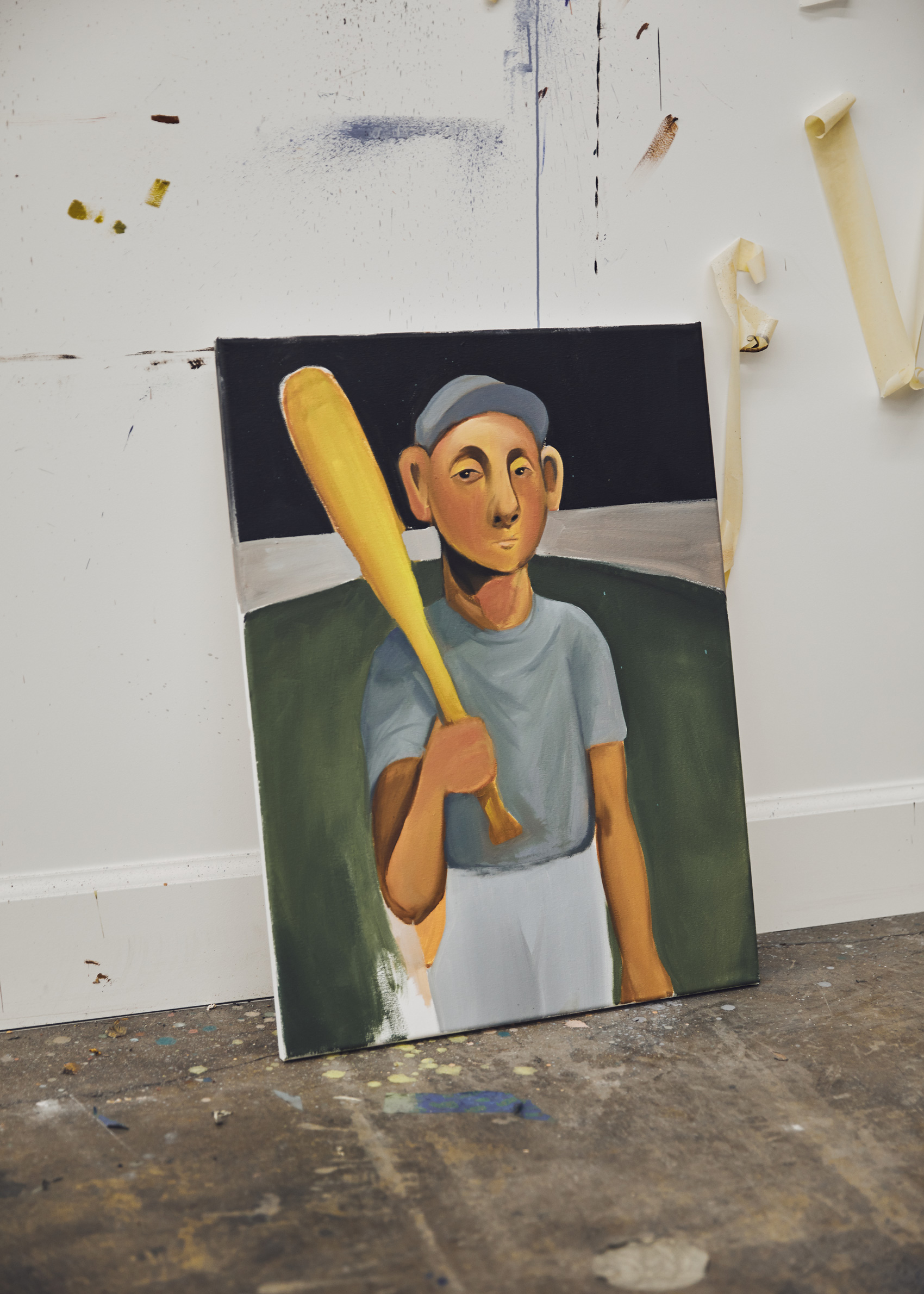
What captivates you about the human figure?
I think people are fascinating. I mean studying science, I was a neuroscientist and it was cool to just look at people and think about how we have no idea what’s going on in there. When I learned to draw, I didn’t take any drawing classes, I would just stare in the mirror and draw myself, which kind of explains why a lot of these pieces look like me. Also, in this age of people taking so many pictures of themselves, you’re constantly seeing this repetitive image every day. Initially, I was just looking at people because I was fascinated by them, and now I’m looking at them because I’m sort of forced to all the time with social media. There’s just so much of the human figure around us all the time. Everything in my work is objective; it’s just me looking at something I couldn’t understand. I think that’s also why most of my characters have no emotion on their faces, you don’t really know what’s going on behind there.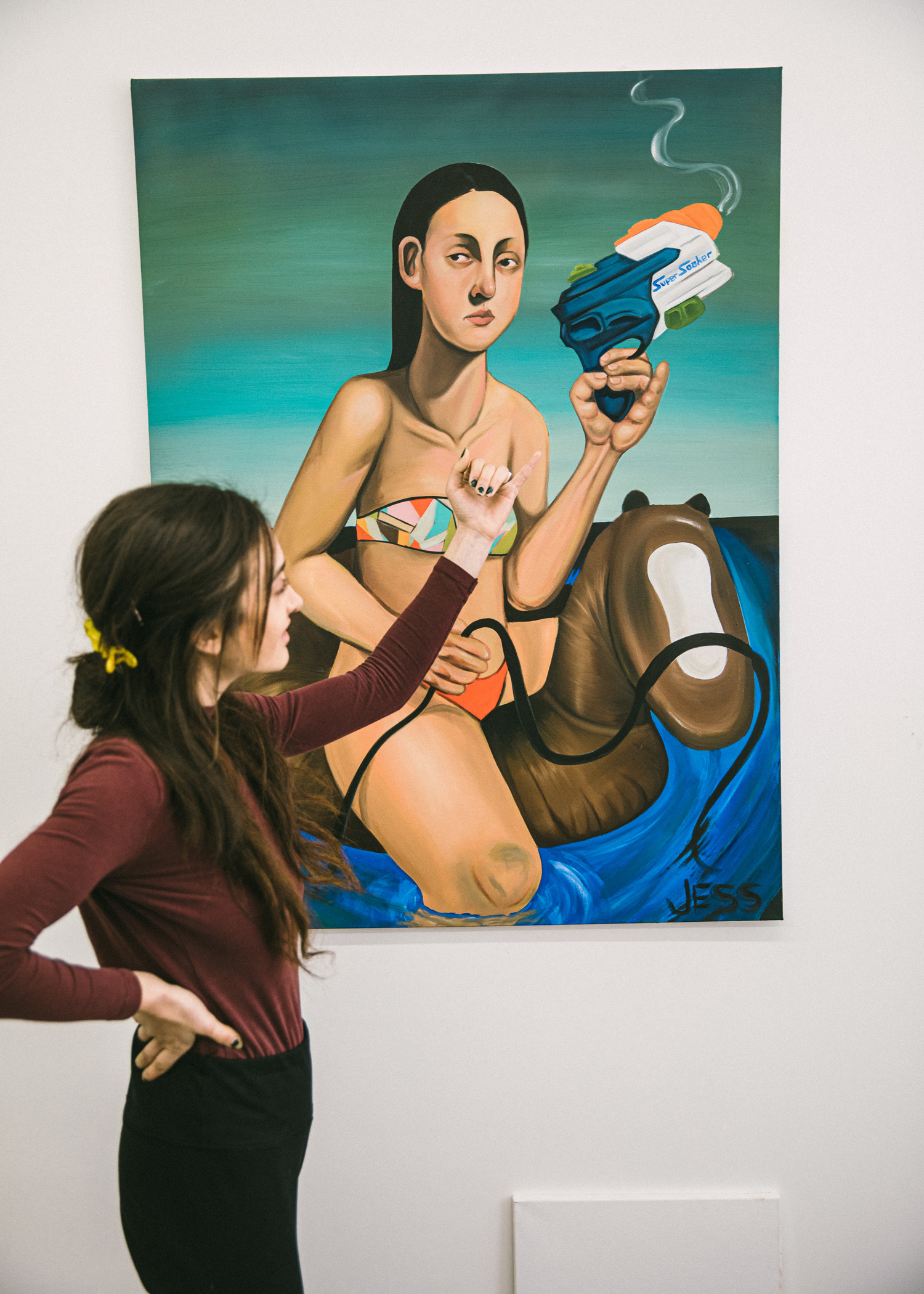
There are undeniably contemporary elements to your work — you interject items like a Super Soaker and Modelo beer bottle into your pieces, but there’s also a recognizably traditional and painterly nature to it. I love that.
Those more contemporary references definitely come from my childhood. For this piece in particular [she points to an image of a woman sitting in a pool floaty boasting a handheld super soaker gun], I just wanted to show somebody that wants something so badly, but they’re using what they have to be that greatest image of themselves. So I was imagining that this person wants to be a cowboy so bad or wants to just have that gritty rambling lifestyle, but they’re somewhere in the Valley in a public swimming pool and all they have is a Super Soaker — so they can only imagine. I’ve always been a fan of modern art and the Old Masters like Caravaggio and Diego Velázquez, so I use their work as a reference to do technical things, but I’m also influenced by Nicole Eisenman and Dana Shutz. I love how they can just have fun with what they are making. I was making regular portraits and I thought that I needed to interject something more fun. I learned to just do something silly and stupid, and find a way to make it work and love it. It’s pretty funny, like this piece over here with the people at the bar, it’s kind of a romantic image, but there are Modelos on the bar and shots of Fernet, and a credit card. The beer tap says “Blue Goon” instead of Blue Moon.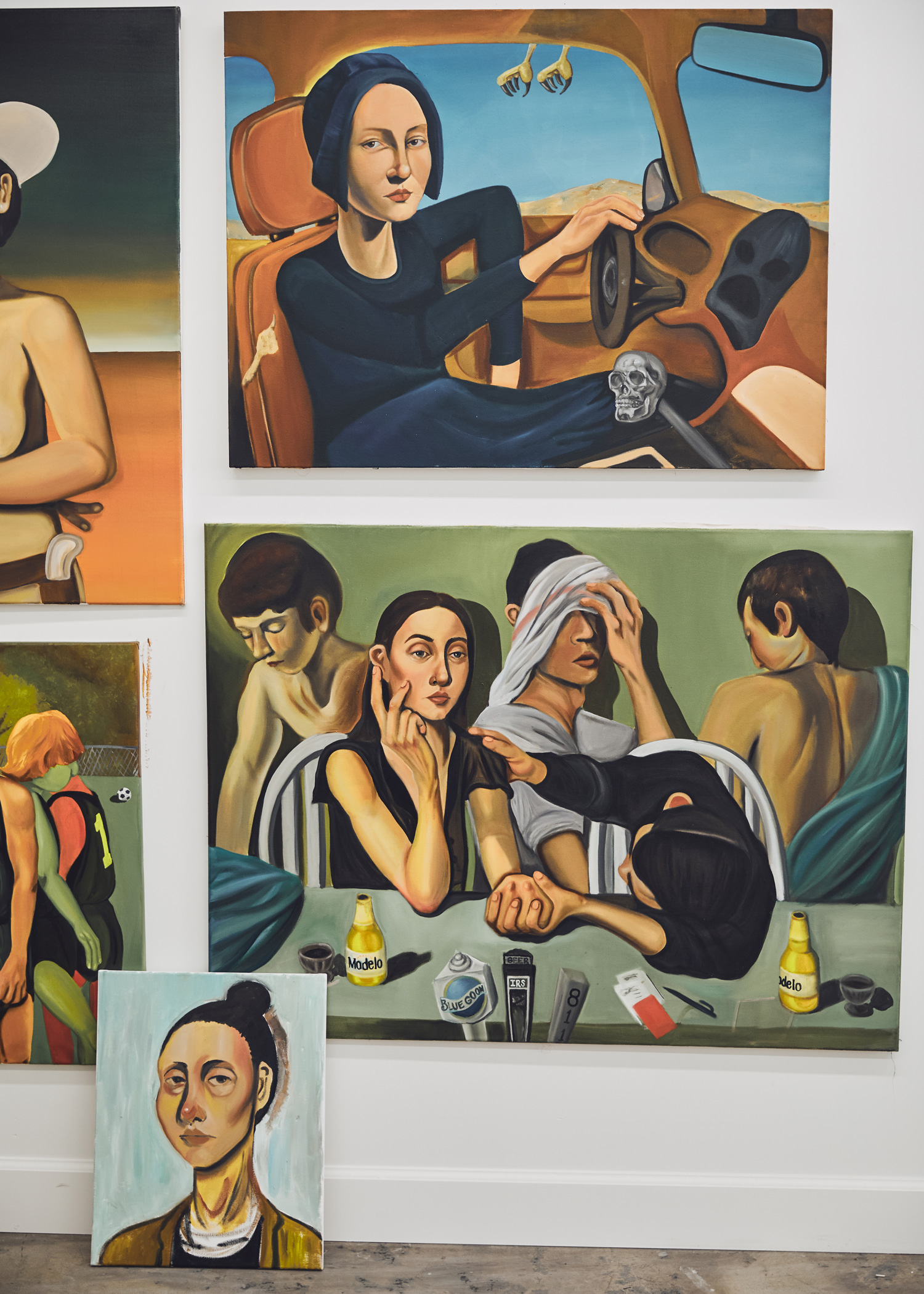
You’ve been painting for a very short amount of time — three years — so I’m sure you’re still learning constantly.
Constantly, constantly learning. And despite the fact that I didn’t get to go to art school and study art in a traditional sense except for a couple of painting classes, you kind of always have to keep growing. I couldn’t even imagine finding my style and being like, “Ok this is it; this is how I’m going to paint for the rest of my life.” No. There are just so many different styles and things to explore. This painting that my friend and artist Austyn bought, was so obscure and different from the other paintings I was making that I’d have studio visits and people would be like, “Yeah, I’d include all of these in a show, but not that one because it’s so different and weird. You should stick to this, keep making things like this.” I would get so discouraged to do things that I actually really like to paint after hearing feedback like that. But I’ve learned to just listen to myself and make the things that I feel like making. Maybe I want to make one that looks like Caravaggio, maybe I want to be George Condo one day, but it’s up to me. I’m still learning how to balance all those things and follow my gut and paint because I love to paint, and just not worry about all the garbage that people are telling me to do.
It’s difficult to block out those outside voices though. It’s interesting that people have encouraged you to stick to a certain style even though you’re truly only at the beginning of your creative career. You’re in this period of constant learning, why would you just stick to one thing?
Yeah, exactly. Who knows what will happen. People could get bored of my work one day and I’m trying to keep evolving my brain. Maybe something that I make that’s totally different than what I usually do is the coolest painting I’ve ever made.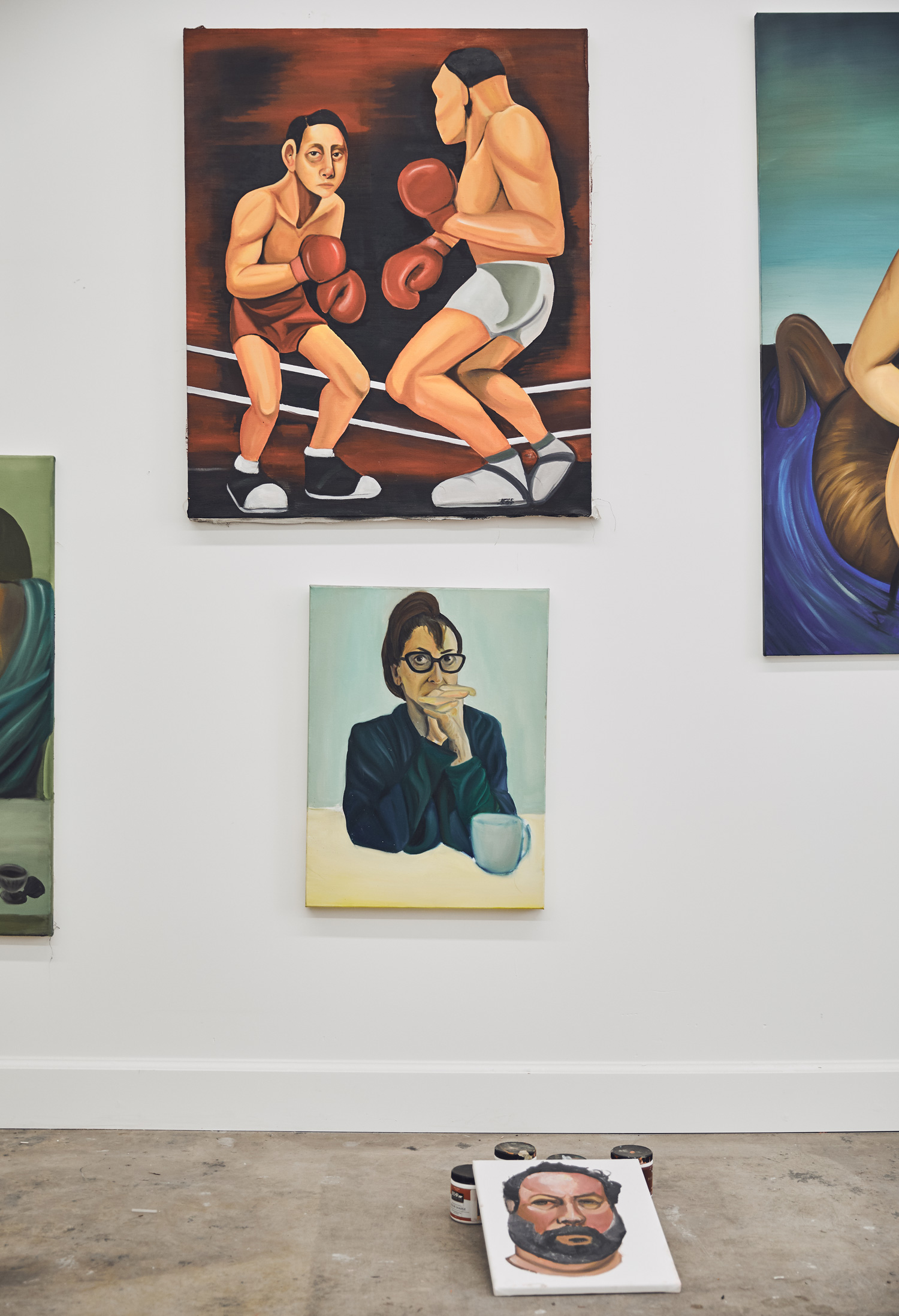
Or you learn something during that painting that’s going to inform your other style.
It always does. I’m learning from every painting that I do and am always referencing my old paintings.
It’s the start of 2020 now, what are you looking forward to this year?
I’m just excited to keep moving. This is kind of the first year that things happened for me. I got my studio in April and I have a couple of shows now and was offered a solo show. Even with the volume of work that I’ve created since then, I can’t even imagine where I’ll be a year from now. I’m enthusiastic. I’m hoping I’ll go a little bit crazier. I think I need to do something nuts. Honestly, with all of these cowboy paintings I’ve been making, I think I need to go to Texas or something and live the life for a minute. Hoping to include a lot of travel this year.
Tell me more about the cowboy motifs you’ve been toying within some of your paintings.
I have this friend, Sam, who has always been this influence of kind of going crazy and being this rambling man, as you call it. He introduced me to that type of country music. I started to recognize the importance of that “rambling man” narrative—someone that’s going off and doing their own thing and no one’s going to stop them. They just stick to their guns. At one point that really, really clicked, and honestly, I’m doing that now. I’ve always been the kind of person that’s like, “I want to do things on my own.” I’ve always been independent and I saw later on how much of a struggle that was for me. I kind of abandoned everybody because I was so busy sticking to what I want to do, but after a while, it gets very lonely. I’ve had people think that I’m just kind of badass because I do whatever I want, but I’m so lonely sometimes and I wonder to myself why I choose to be on my own when I really want to be around people I love. So yeah, you don’t really know what happens with the rambling man. There’s lots of hurt, lots of struggle. There’s lots of love and sadness. And I found that in country music — cowboys, they feel me, they get it.
So with the painting in the corner of the sheriff, there’s nothing around her, but her gaze gives off that “this town still isn’t big enough for the two of us” type of thing. She’s ready to get rid of you, but you don’t really know what she’s thinking still. Maybe she secretly wants you to stick around.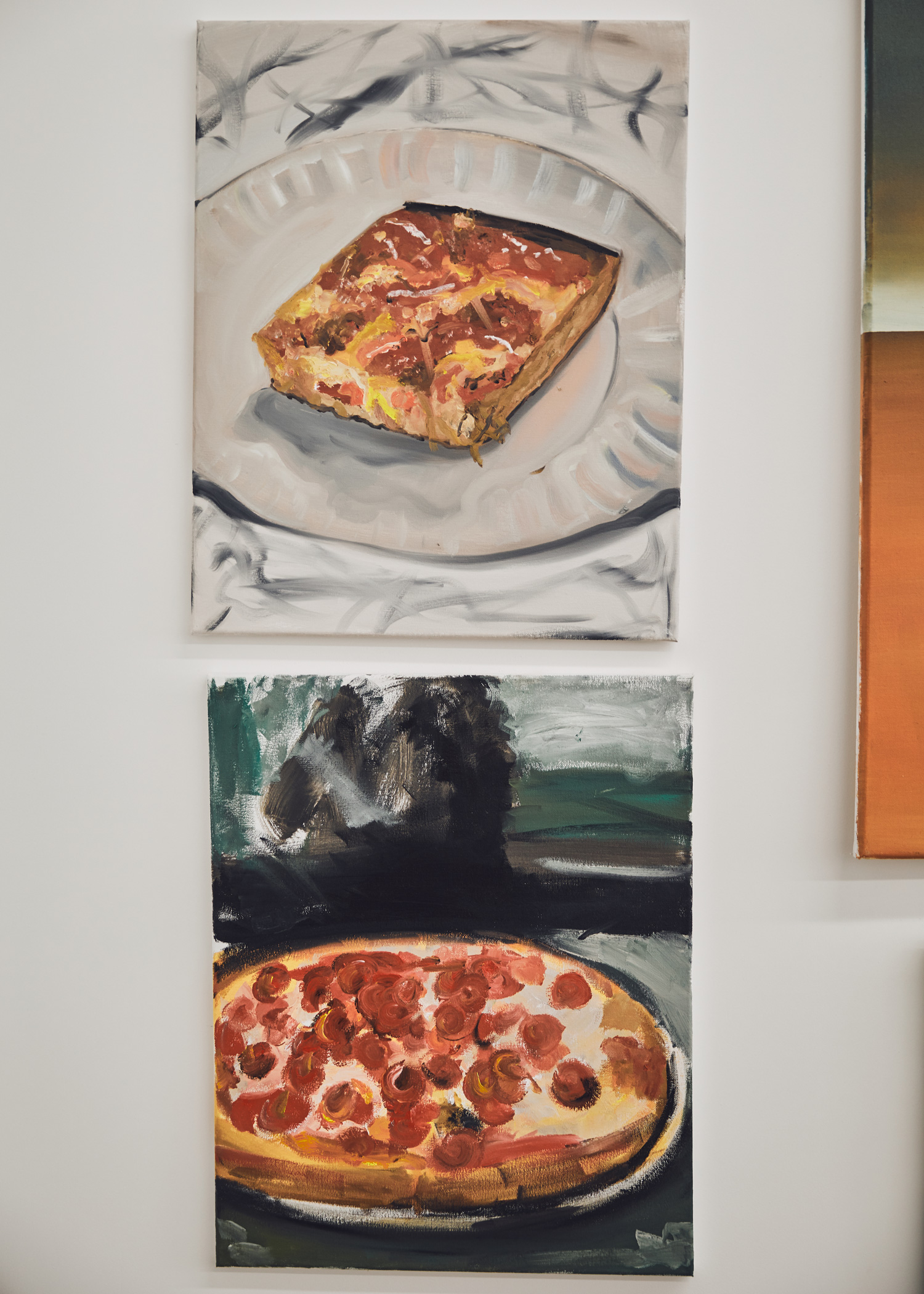
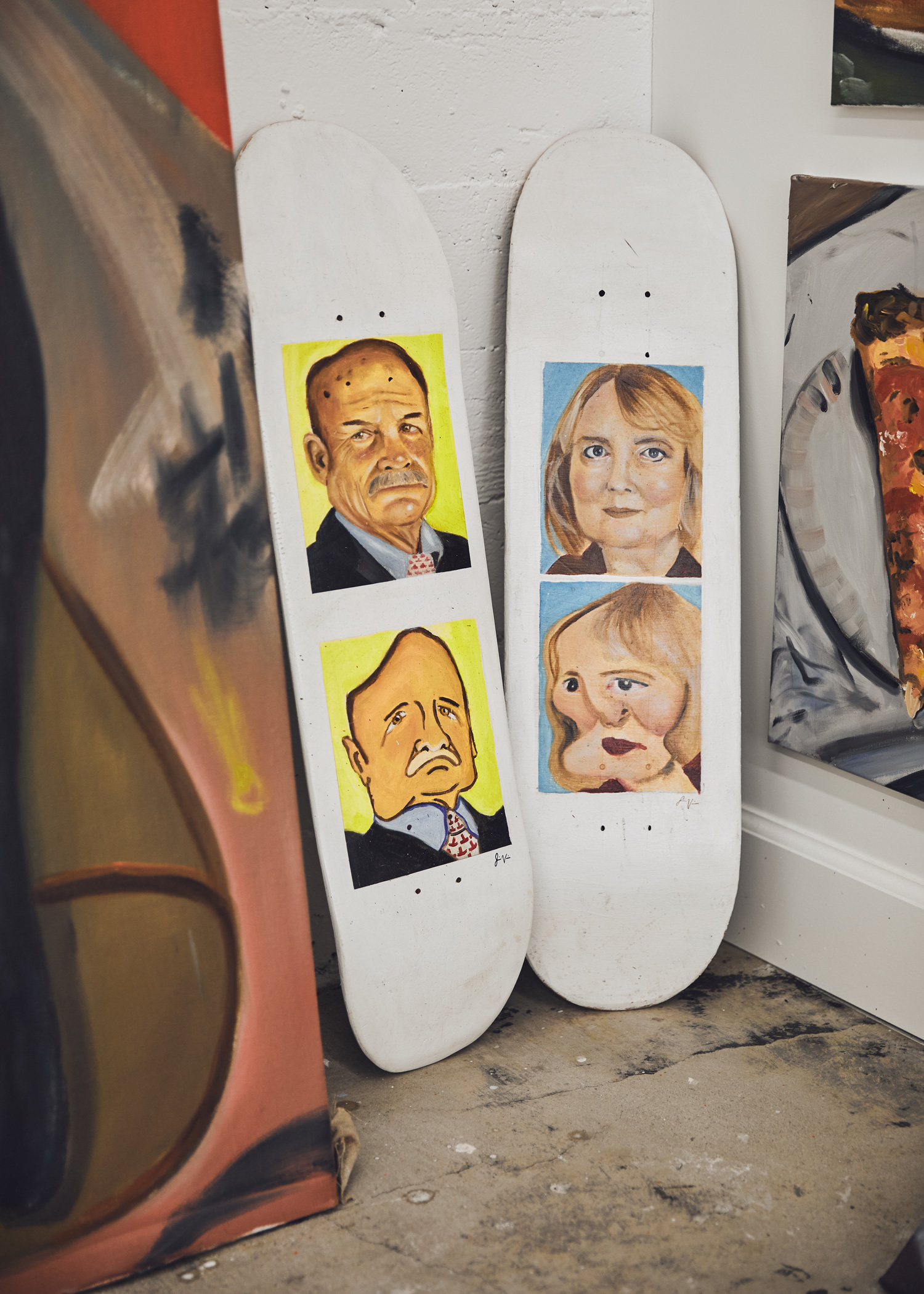
Do you think that some of your characters are lonely or are part of a lonely narrative?
It’s loneliness, it’s longing, it’s fear. Everything has to do with some kind of emotion that’s triggering chest pain or something, you know? Or they’re just trying to get away from everybody. So it is a sense of being alone. The fighter, for example, could go any way. He could be alone because he’s about to get knocked out. Or he could be looking at you saying like, “I’m doing this for you,” or “Can’t wait to see you after this, take me to the hospital.”
I remember this interview with Frida Khalo and she said something along the lines of, “I paint myself because no one else is around.” I think that makes sense, and I connected with that sentiment. I paint all of these lonely people because, for a long time, I was very lonely because I just wanted to do my thing.
Are the people in your paintings are in some way an expression or piece of you?
Yeah, I think I kind of live vicariously through all of my subjects. Everything is created based on my own experiences. I’m in this weird situation where so many of my paintings were based on stress. And then things were going pretty well, and I was like, “Shit, that was my motive for those paintings.” I was so sad and bummed and making all these paintings. But what’s inspiring me now is just my personal growth. I’m on this journey and a lot of these paintings in the studio now are the beginnings of that journey. What’s inspiring me is that I might be getting close to what that journey may be.
For more from Jess Valice, follow her on Instagram. 
